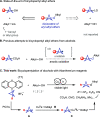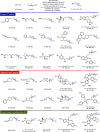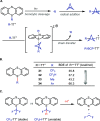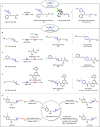Bicyclopentylation of Alcohols with Thianthrenium Reagents
- PMID: 38010346
- PMCID: PMC10704608
- DOI: 10.1021/jacs.3c10024
Bicyclopentylation of Alcohols with Thianthrenium Reagents
Erratum in
-
Addition to "Bicyclopentylation of Alcohols with Thianthrenium Reagents".J Am Chem Soc. 2024 Jan 24;146(3):2288. doi: 10.1021/jacs.4c00054. Epub 2024 Jan 11. J Am Chem Soc. 2024. PMID: 38212883 Free PMC article. No abstract available.
Abstract
Herein we present the first method for the synthesis of bicyclo[1.1.1]pentyl (BCP) alkyl ethers from alcohols. The reaction uses BCP-thianthrenium reagents and is catalyzed by a dual copper/photoredox catalyst system. Unlike known alkylations of tertiary alcohols via carbocation intermediates, our Cu-mediated radical process circumvents the labile BCP carbocations. The approach demonstrates a broad tolerance for functional groups when applied to primary, secondary, and even tertiary alcohols. In addition, we highlight the utility of this method in late-stage functionalizations of both natural products and pharmaceuticals as well as in the rapid construction of BCP analogs of known pharmaceuticals that would otherwise be difficult to access.
Conflict of interest statement
The authors declare the following competing financial interest(s): T.R. and Z.B. may benefit from thianthrene compound-based sales.
Figures





Similar articles
-
Copper-Photoredox-Catalyzed C(sp3)-C(sp3) Reductive Cross-Coupling of Alkyl Bromides with BCP-Thianthrenium Reagents.Angew Chem Int Ed Engl. 2025 Jul 21;64(30):e202506785. doi: 10.1002/anie.202506785. Epub 2025 May 26. Angew Chem Int Ed Engl. 2025. PMID: 40391618 Free PMC article.
-
Enabling the Use of Alkyl Thianthrenium Salts in Cross-Coupling Reactions by Copper Catalysis.Angew Chem Int Ed Engl. 2021 Sep 27;60(40):21756-21760. doi: 10.1002/anie.202109723. Epub 2021 Aug 26. Angew Chem Int Ed Engl. 2021. PMID: 34378844
-
Photoinduced Regioselective Fluorination and Vinylation of Remote C(sp3)-H Bonds Using Thianthrenium Salts.Org Lett. 2024 May 24;26(20):4388-4393. doi: 10.1021/acs.orglett.4c01420. Epub 2024 May 16. Org Lett. 2024. PMID: 38752694
-
Aryl Radical Activation of C-O Bonds: Copper-Catalyzed Deoxygenative Difluoromethylation of Alcohols.J Am Chem Soc. 2021 Jul 7;143(26):9952-9960. doi: 10.1021/jacs.1c04254. Epub 2021 Jun 28. J Am Chem Soc. 2021. PMID: 34180233
-
Photoredox Catalysis-Enabled Sulfination of Alcohols and Bromides.J Am Chem Soc. 2023 Sep 27;145(38):20767-20774. doi: 10.1021/jacs.3c08216. Epub 2023 Sep 18. J Am Chem Soc. 2023. PMID: 37721547 Free PMC article.
Cited by
-
Late-Stage Cross-Electrophile Coupling of Arylthianthrenium Salts with (Hetero)aryl (Pseudo)halides via Palladium Catalysis.Angew Chem Int Ed Engl. 2025 Jun 10;64(24):e202502441. doi: 10.1002/anie.202502441. Epub 2025 Apr 14. Angew Chem Int Ed Engl. 2025. PMID: 40192531 Free PMC article.
-
Copper-Photoredox-Catalyzed C(sp3)-C(sp3) Reductive Cross-Coupling of Alkyl Bromides with BCP-Thianthrenium Reagents.Angew Chem Int Ed Engl. 2025 Jul 21;64(30):e202506785. doi: 10.1002/anie.202506785. Epub 2025 May 26. Angew Chem Int Ed Engl. 2025. PMID: 40391618 Free PMC article.
-
Facile Access to Hindered Ethers via Photoinduced O-H Bond Insertions.ACS Cent Sci. 2025 Apr 23;11(5):742-752. doi: 10.1021/acscentsci.5c00099. eCollection 2025 May 28. ACS Cent Sci. 2025. PMID: 40454338 Free PMC article.
References
-
- Pellicciari R.; Raimondo M.; Marinozzi M.; Natalini B.; Costantino G.; Thomsen C. (S)-(+)-2-(3′-Carboxybicyclo[1.1.1]pentyl)-glycine, a Structurally New Group I Metabotropic Glutamate Receptor Antagonist. J. Med. Chem. 1996, 39, 2874–2876. 10.1021/jm960254o. - DOI - PubMed
- Filosa R.; Carmela Fulco M.; Marinozzi M.; Giacchè N.; Macchiarulo A.; Peduto A.; Massa A.; de Caprariis P.; Thomsen C.; Christoffersen C. T.; Pellicciari R. Design, synthesis and biological evaluation of novel bicyclo[1.1.1]pentane-based ω-acidic amino acids as glutamate receptors ligands. Bioorg. Med. Chem. 2009, 17, 242–250. 10.1016/j.bmc.2008.11.015. - DOI - PubMed
-
- Stepan A. F.; Subramanyam C.; Efremov I. V.; Dutra J. K.; O’Sullivan T. J.; DiRico K. J.; McDonald W. S.; Won A.; Dorff P. H.; Nolan C. E.; Becker S. L.; Pustilnik L. R.; Riddell D. R.; Kauffman G. W.; Kormos B. L.; Zhang L.; Lu Y.; Capetta S. H.; Green M. E.; Karki K.; Sibley E.; Atchison K. P.; Hallgren A. J.; Oborski C. E.; Robshaw A. E.; Sneed B.; O’Donnell C. J. Application of the bicyclo[1.1.1]pentane motif as a nonclassical phenyl ring bioisostere in the design of a potent and orally active gamma-secretase inhibitor. J. Med. Chem. 2012, 55, 3414–3424. 10.1021/jm300094u. - DOI - PubMed
- Auberson Y. P.; Brocklehurst C.; Furegati M.; Fessard T. C.; Koch G.; Decker A.; La Vecchia L.; Briard E. Improving Nonspecific Binding and Solubility: Bicycloalkyl Groups and Cubanes as para-Phenyl Bioisosteres. ChemMedChem 2017, 12, 590–598. 10.1002/cmdc.201700082. - DOI - PubMed
- Goh Y. L.; Cui Y. T.; Pendharkar V.; Adsool V. A. Toward Resolving the Resveratrol Conundrum: Synthesis and in Vivo Pharmacokinetic Evaluation of BCP-Resveratrol. ACS Med. Chem. Lett. 2017, 8, 516–520. 10.1021/acsmedchemlett.7b00018. - DOI - PMC - PubMed
- Measom N. D.; Down K. D.; Hirst D. J.; Jamieson C.; Manas E. S.; Patel V. K.; Somers D. O. Investigation of a Bicyclo[1.1.1]pentane as a Phenyl Replacement within a LpPLA2 Inhibitor. ACS Med. Chem. Lett. 2017, 8, 43–48. 10.1021/acsmedchemlett.6b00281. - DOI - PMC - PubMed
-
- Gianatassio R.; Lopchuk J. M.; Wang J.; Pan C.-M.; Malins L. R.; Prieto L.; Brandt T. A.; Collins M. R.; Gallego G. M.; Sach N. W.; Spangler J. E.; Zhu H.; Zhu J.; Baran P. S. Strain-release amination. Science 2016, 351, 241–246. 10.1126/science.aad6252. - DOI - PMC - PubMed
- Kanazawa J.; Maeda K.; Uchiyama M. Radical Multicomponent Carboamination of [1.1.1]Propellane. J. Am. Chem. Soc. 2017, 139, 17791–17794. 10.1021/jacs.7b11865. - DOI - PubMed
- Hughes J. M. E.; Scarlata D. A.; Chen A. C.; Burch J. D.; Gleason J. L. Aminoalkylation of [1.1.1]Propellane Enables Direct Access to High-Value 3-Alkylbicyclo[1.1.1]pentan-1-amines. Org. Lett. 2019, 21, 6800–6804. 10.1021/acs.orglett.9b02426. - DOI - PubMed
- Zhang X.; Smith R. T.; Le C.; McCarver S. J.; Shireman B. T.; Carruthers N. I.; MacMillan D. W. C. Copper-mediated synthesis of drug-like bicyclopentanes. Nature 2020, 580, 220–226. 10.1038/s41586-020-2060-z. - DOI - PMC - PubMed
- Pickford H. D.; Nugent J.; Owen B.; Mousseau J. J.; Smith R. C.; Anderson E. A. Twofold Radical-Based Synthesis of N,C-Difunctionalized Bicyclo[1.1.1]pentanes. J. Am. Chem. Soc. 2021, 143, 9729–9736. 10.1021/jacs.1c04180. - DOI - PubMed
- Shin S.; Lee S.; Choi W.; Kim N.; Hong S. Visible-Light-Induced 1,3-Aminopyridylation of [1.1.1]Propellane with N-Aminopyridinium Salts. Angew. Chem., Int. Ed. 2021, 60, 7873–7879. 10.1002/anie.202016156. - DOI - PubMed
- Livesley S.; Sterling A. J.; Robertson C. M.; Goundry W. R. F.; Morris J. A.; Duarte F.; Aissa C. Electrophilic Activation of [1.1.1]Propellane for the Synthesis of Nitrogen-Substituted Bicyclo[1.1.1]pentanes. Angew. Chem., Int. Ed. 2022, 61, e20211129110.1002/anie.202111291. - DOI - PMC - PubMed
- Alvarez E. M.; Bai Z.; Pandit S.; Frank N.; Torkowski L.; Ritter T. O-, N- and C-bicyclopentylation using thianthrenium reagents. Nat. Synth. 2023, 2, 548–556. 10.1038/s44160-023-00277-8. - DOI
LinkOut - more resources
Full Text Sources

